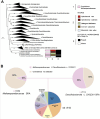Methanotrophic Flexibility of 'Ca. Methanoperedens' and Its Interactions With Sulphate-Reducing Bacteria in the Sediment of Meromictic Lake Cadagno
- PMID: 40641180
- PMCID: PMC12246660
- DOI: 10.1111/1462-2920.70133
Methanotrophic Flexibility of 'Ca. Methanoperedens' and Its Interactions With Sulphate-Reducing Bacteria in the Sediment of Meromictic Lake Cadagno
Abstract
The greenhouse gas methane is an important contributor to global warming, with freshwater sediments representing important potential methane sources. Anaerobic methane-oxidising archaea mitigate methane release into the atmosphere by coupling the oxidation of methane to the reduction of extracellular electron acceptors or through interspecies electron transfer with microbial partners. Understanding their metabolic flexibility and microbial interactions is crucial to assess their role in global methane cycling. Here, we investigated anoxic sediments of the meromictic freshwater Lake Cadagno (Switzerland), where 'Ca. Methanoperedens' co-occur with a specific sulphate-reducing bacterium, with metagenomics and long-term incubations. Incubations were performed with different electron acceptors, revealing that manganese oxides supported highest CH4 oxidation potential but enriched for 'Ca. Methanoperedens' phylotypes that were hardly present in the inoculum. Combining data from the inoculum and incubations, we obtained five 'Ca. Methanoperedens' genomes, each harbouring different extracellular electron transfer pathways. In a reconstructed Desulfobacterota QYQD01 genome, we observed large multi-heme cytochromes, type IV pili, and a putative loss of hydrogenases, suggesting facultative syntrophic interactions with 'Ca. Methanoperedens'. This research deepens our understanding of the metabolic flexibility and potential interspecific interactions of 'Ca. Methanoperedens' in freshwater lakes.
© 2025 The Author(s). Environmental Microbiology published by John Wiley & Sons Ltd.
Conflict of interest statement
The authors declare no conflicts of interest.
Figures





Similar articles
-
Electron acceptors modulate methane oxidation and active methanotrophic communities in anoxic urban wetland sediments.Appl Environ Microbiol. 2025 Aug 20;91(8):e0038625. doi: 10.1128/aem.00386-25. Epub 2025 Jul 31. Appl Environ Microbiol. 2025. PMID: 40742164 Free PMC article.
-
A ubiquitous and diverse methanogenic community drives microbial methane cycling in eutrophic coastal sediments.FEMS Microbiol Ecol. 2025 Jul 14;101(8):fiaf075. doi: 10.1093/femsec/fiaf075. FEMS Microbiol Ecol. 2025. PMID: 40650567 Free PMC article.
-
Dissolved organic matter and sulfide enhance the CH4 consumption of a psychrophilic lake methanotroph, Methylobacter sp. S3L5C.Microbiol Spectr. 2025 Jul;13(7):e0313324. doi: 10.1128/spectrum.03133-24. Epub 2025 Jun 9. Microbiol Spectr. 2025. PMID: 40488469 Free PMC article.
-
Current trends in electromicrobiology of methane oxidation.Trends Microbiol. 2025 Jul;33(7):782-795. doi: 10.1016/j.tim.2025.02.012. Epub 2025 Mar 29. Trends Microbiol. 2025. PMID: 40158907 Review.
-
Metabolic potential of anaerobic methane oxidizing archaea for a broad spectrum of electron acceptors.Adv Microb Physiol. 2022;80:157-201. doi: 10.1016/bs.ampbs.2022.01.003. Epub 2022 Feb 18. Adv Microb Physiol. 2022. PMID: 35489791 Review.
References
-
- Alneberg, J. , Bjarnason B. S., de Bruijn I., et al. 2014. “Binning Metagenomic Contigs by Coverage and Composition.” Nature Methods 11: 1144–1146. - PubMed
-
- Arshad, A. , Dalcin Martins P., Frank J., Jetten M. S. M., Op den Camp H. J. M., and Welte C. U.. 2017. “Mimicking Microbial Interactions Under Nitrate‐Reducing Conditions in an Anoxic Bioreactor: Enrichment of Novel Nitrospirae Bacteria Distantly Related to Thermodesulfovibrio .” Environmental Microbiology 19: 4965–4977. - PubMed
MeSH terms
Substances
Grants and funding
LinkOut - more resources
Full Text Sources

